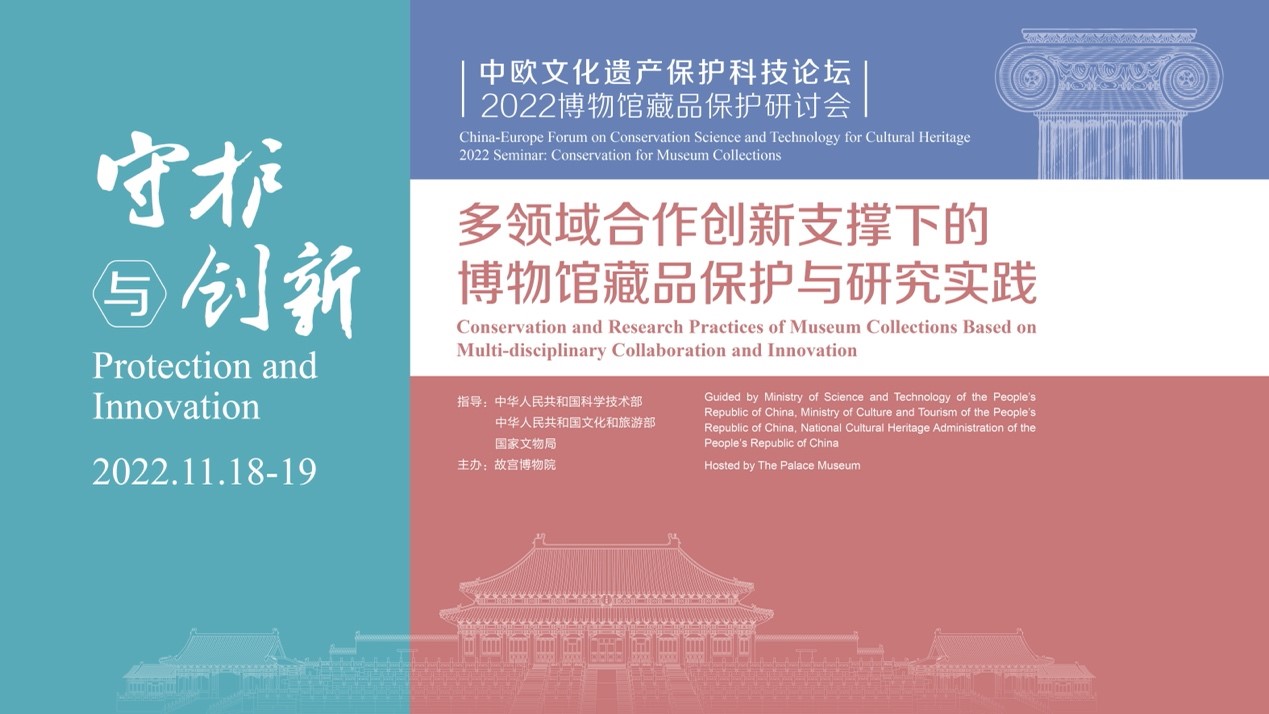The China-Europe Forum on Conservation Science and
Technology for Cultural Heritage and 2022 Seminar: Conservation for Museum
Collections was held in Beijing between 18 and 19 November. The events were
organised by the Palace Museum, supervised by China’s Ministries of Science and
Technology and Culture and Tourism and National Cultural Heritage
Administration and undertaken by the China-Greece Belt-and-Road Joint
Laboratory on Cultural Heritage Conservation Technology (Joint Laboratory), Key
Laboratory of Calligraphy and Painting Conservation, Ministry of Culture and
Tourism and Key Scientific Research Base of Research on the Conservation of
Ancient Ceramics, State Administration of Cultural Heritage.

Poster of the seminar.
The seminar’s theme: “Protection and Innovation:
Conservation and Research Practices of Museum Collections Based on
Multi-disciplinary Collaboration and Innovation” aimed to encourage
communication among experts and scholars from China and Europe. It also hoped
to promote and strengthen mutual understanding, inspire innovation and build a
platform for preserving and passing on the beauty of cultural heritage.
The seminar took place both online and offline, and the opening ceremony was hosted by Zhao Guoying, deputy curator of the Palace Museum and director of the Joint Laboratory. Speeches were delivered by Wang Xudong, member of China’s Ministry of Culture and Tourism’s leading Party members’ group and curator of the Palace Museum; Dai Gang, director-general of the Department of International Cooperation of China’s Ministry of Science and Technology; Li Wei, director-general of the Department of Science and Technology Education of China’s Ministry of Culture and Tourism; Luo Jing, director-general of the National Cultural Heritage Administration’s Department of Science and Technology Education; and Spiros Anastasiadis, former director of the Institute of Electronic Structure and Laser (IESL-FORTH).
Deputy Director Zhao hosted the opening ceremony.
Director-general Dai stated in his address that
science and technology were the key drivers for cultural heritage preservation.
China’s scientific and technological collaboration with Europe in cultural
heritage preservation began early in different fields and had diverse models,
and the successful experience over the years showed the building of
scientific-research platforms, launching of scientific-research projects and
cultivation of science and technology talents facilitated scientific and
technological collaboration in cultural heritage preservation. Dai recognised
the marked progress achieved by the Joint Laboratory co-established by the
Palace Museum and IESL-FORTH. He also hoped the seminar would provide an
invaluable lesson for open communication in artefact and cultural heritage
preservation.
Dai, director-general of the Department of
International Cooperation of China’s Ministry of Science and Technology,
delivered a speech via video.
Director-general Li stated in her speech that cultural
exchanges between Europe and China dated back a long time and the distinctive
cultures co-existed in great harmony. China and its leaders placed great
emphasis on the preservation, passing on and application of cultural heritage
and actively promoted the creative transformation and innovative development of
China’s outstanding traditional culture. She added that major European museums
and research institutes had achieved remarkable results in the scientific
preservation of cultural heritage. The forum would provide a great opportunity
for communication and exchange among culture scholars and experts from both
Europe and China. She hoped that experts and scholars attending the seminar
would be able to benefit from it and be inspired in their future research.
Li, a first-class inspector from China’s Ministry of
Culture Tourism, delivered a speech.
Director-general Luo stated in his speech that thanks
to the strong support from China’s Ministry of Science and Technology, China’s
international collaboration in cultural-heritage preservation had achieved
great success. He spoke highly of the Palace Museum’s positive contribution to
promoting international academic exchanges in cultural preservation,
scientific-research collaboration, talents cultivation and institute
establishment in the new era. He hoped that Europe and China would expand their
scientific and technological coordination and innovation in artefacts. He also
looked forward to both sides contributing to the preservation of culture
heritage shared by mankind through the promotion of international scientific
and technological collaboration and programmes, platform development,
innovative mechanisms, resource sharing and collaborative research focusing on
topics of general concern, such as comparative studies of early human
civilisations, climate change and cultural-heritage preservation, cultural-heritage
risk management and the application of new-high technology in cultural-heritage
preservation.
Luo Jing, director-general from the National Cultural
Heritage Administration, delivered a speech.
Anastasiadis, former director of IESL-FORTH, reviewed
the collaboration between the Palace Museum and IESL-FORTH in the laser
cleaning of artefacts. He hoped that more museums and research institutes from
China and Europe would engage in closer collaboration after this seminar.
Spiros Anastasiadis, former director of IESL-FORTH,
delivered a speech.
Curator Wang remarked that the Palace Museum had
always been a place for cultural and scientific and technological exchange and
integration. The Palace Museum had in recent years extensively engaged in the
cultivation of international talent, the building of interdisciplinary
coordination and innovation platforms and the holding of academic forums. He
added that it was the museum’s historical mission to authentically and wholly
preserve and responsibly pass on China’s outstanding traditional culture as was
borne by the museum. The support and participation of every social sector,
including the museum’s international peers, were required to achieve the
museum’s for major objectives, namely turning the museum into an
internationally leading museum, an example of global cultural-heritage
preservation, a bellwether in culture and tourism integration and a meeting
place for learning Chinese culture. He hoped that under the supervision of
China’s Ministries of Science and Technology and Culture and Tourism and the
National Cultural Heritage Administration, the Palace museum would continue and
expand its collaboration with countries from around the globe. In addition to
passing on and preserving China’s outstanding cultural heritage, the museum
hoped to contribute to the preservation of cultural heritage from around the
world.
Director Wang delivered a speech.
At the two-day seminar, 18 experts from the U.K.,
Italy, France, the Netherlands, Switzerland, Greece and China discussed and
communicated extensively on the preservation and new scientific-analysis
methods for artefacts, including textiles, paper, murals, pigments, metal and
coloured glaze; research on new technologies and materials; and
multidisciplinary collaboration in the preservation and conservation of museum
collections.
The seminar attracted over 1,000 online viewers from
home and abroad and was divided into four sessions. The first was hosted by
Austin Nevin, professor at the U.K.’s Courtauld Institute of Art, and included
reports by Angelika Sliwka from the Abegg Foundation in Switzerland with the
title of “Preservation and Conservation of Chinese Textiles: An Example of the
Conversation of Brocade from between the 5th and 7th Centuries”; Zhou Yang from China National Silk Museum with the title of
“Research and Application of the Testing Technology for Silk Microtraces Based
on the Principles of Immunology”; Maria Perla Colombini and Ilaria Bonaduce
from Italy’s University of Pisa with the title of “Difficulties and Challenges
in the Scientific Research and Protein Analysis of Painting Materials”; and
Chen Gang from China’s Fudan University with the title of “The Way of Paper:
Scientific Research on Early Ancient Paper in Northwest China”.
The second session was hosted by Qu Liang, director of
the Palace Museum’s Conservation Standards Research Institute, and included
reports by Ina Reiche from the French Ministry of Culture and the French
National Centre for Scientific Research (Centre national de la recherche
scientifique) with the title of “Research on the Application of Multispectral
Imaging to Faded Pigments”; Zhou Ping from China’s Emperor Qinshihuang’s
Mausoleum Site Museum with the title of “Multidisciplinary and Multifield
Collaboration to Improve the Preservation, Conservation and Active Use of
Colours on the Terra-Cotta Army”; Austin Nevin from the U.K.’s Courtauld
Institute of Art with the title of “Scientific Analysis and Preservation of
Murals: Case Studies from Cyprus and China”; Ma Qinglin from China’s Shandong
University with the title of “Research on Simulated Restoration of the Colours
and Textures of Coloured Artefacts: A Case Study of the Colour-Painted
Bodhidharma Statues in Lingyan Temple in Shandong”; and Xu Qingmeng from
China’s Shanghai University with the title of “Preparation and Application of
Cellulose Nanocrystals in the Preservation of Paper”.
The third session was hosted by Dr Paraskevi Pouli
from IESL-FORTH and included reports by Sara Creange from the Netherlands’
Rijksmuseum with the title of “The Rijksmuseum’s Collaboration and Innovation:
From the Perspective of the Preservation of Metal Artefacts”; Zhang Ran from
the National Museum of China with the title of “Research and Practice of the
General Assessment System for the Stability of Fragile Iron Artefacts in
Museums”; Jenny Perdikari from Greece’s Byzantine and Christian Museum with the
title of “Preservation and Research on the Icons of the Byzantine and Christian
Museum”; and Kang Baoqiang from China’s Palace Museum with the title of
“Emergence and Development of Coloured Glaze in Ancient Chinese Architecture”.
The fourth session was hosted by Lei Yong from China’s
Palace Museum and included reports by Dr Paraskevi Pouli from IESL-FORTH with
the title of “Lighting up Artefacts and Relics with Laser: Analysis, Diagnosis
and Preservation”; Wei Xiangjun from Shanghai Synchrotron Radiation Facility/
Shanghai Advanced Research Institute of the Chinese Academy of Sciences with
the title of “Research on Synchrotron Radiation of Colour-Painted Artefacts of
the Palace Museum”; Bai Xueshi from the National Centre for Research and
Restoration in French Museums (Centre de recherche et de restauration des
musées de France) with the title of “Application of Laser-Induced Breakdown
Spectroscopy to Scientific Research on Cultural Heritage”; Ding Zhongming from
China’s Shanghai Museum with the title of “Research on the Production
Techniques of Decorative Round Sculpted Bronze Ware of the Jin State: On the
Evolution of Production Techniques of Bronze Ware from the Spring and Autumn
Period”; and Qu Liang from the Palace Museum with the title of “Examples of
Scientific and Technological Collaboration and Standardisation of Collections
at the Palace Museum”.
Forum agenda.
Forum agenda.
Reporters at the forum.







